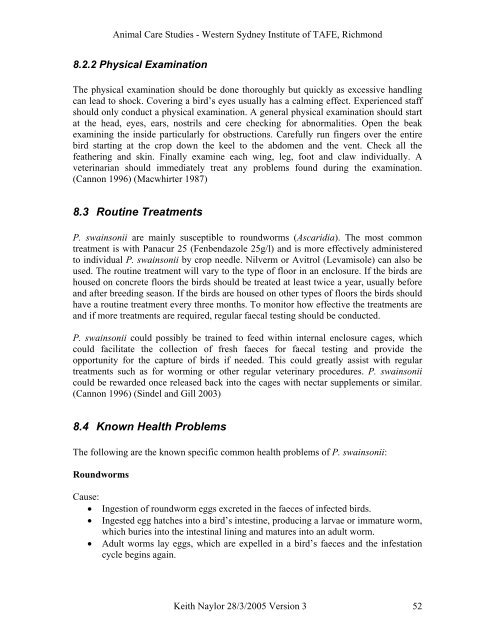Create successful ePaper yourself
Turn your PDF publications into a flip-book with our unique Google optimized e-Paper software.
Animal Care Studies - Western Sydney Institute of TAFE, Richmond8.2.2 Physical ExaminationThe physical examination should be done thoroughly but quickly as excessive handlingcan lead to shock. Covering a bird’s eyes usually has a calming effect. Experienced staffshould only conduct a physical examination. A general physical examination should startat the head, eyes, ears, nostrils and cere checking for abnormalities. Open the beakexamining the inside particularly for obstructions. Carefully run fingers over the entirebird starting at the crop down the keel to the abdomen and the vent. Check all thefeathering and skin. Finally examine each wing, leg, foot and claw individually. Aveterinarian should immediately treat any problems found during the examination.(Cannon 1996) (Macwhirter 1987)8.3 Routine TreatmentsP. swainsonii are mainly susceptible to roundworms (Ascaridia). The most commontreatment is with Panacur 25 (Fenbendazole 25g/l) and is more effectively administeredto individual P. swainsonii by crop needle. Nilverm or Avitrol (Levamisole) can also beused. The routine treatment will vary to the type of floor in an enclosure. If the birds arehoused on concrete floors the birds should be treated at least twice a year, usually beforeand after breeding season. If the birds are housed on other types of floors the birds shouldhave a routine treatment every three months. To monitor how effective the treatments areand if more treatments are required, regular faecal testing should be conducted.P. swainsonii could possibly be trained to feed within internal enclosure cages, whichcould facilitate the collection of fresh faeces for faecal testing and provide theopportunity for the capture of birds if needed. This could greatly assist with regulartreatments such as for worming or other regular veterinary procedures. P. swainsoniicould be rewarded once released back into the cages with nectar supplements or similar.(Cannon 1996) (Sindel and Gill 2003)8.4 Known Health ProblemsThe following are the known specific common health problems of P. swainsonii:RoundwormsCause:• Ingestion of roundworm eggs excreted in the faeces of infected birds.• Ingested egg hatches into a bird’s intestine, producing a larvae or immature worm,which buries into the intestinal lining and matures into an adult worm.• Adult worms lay eggs, which are expelled in a bird’s faeces and the infestationcycle begins again.Keith Naylor 28/3/2005 Version 3 52
















